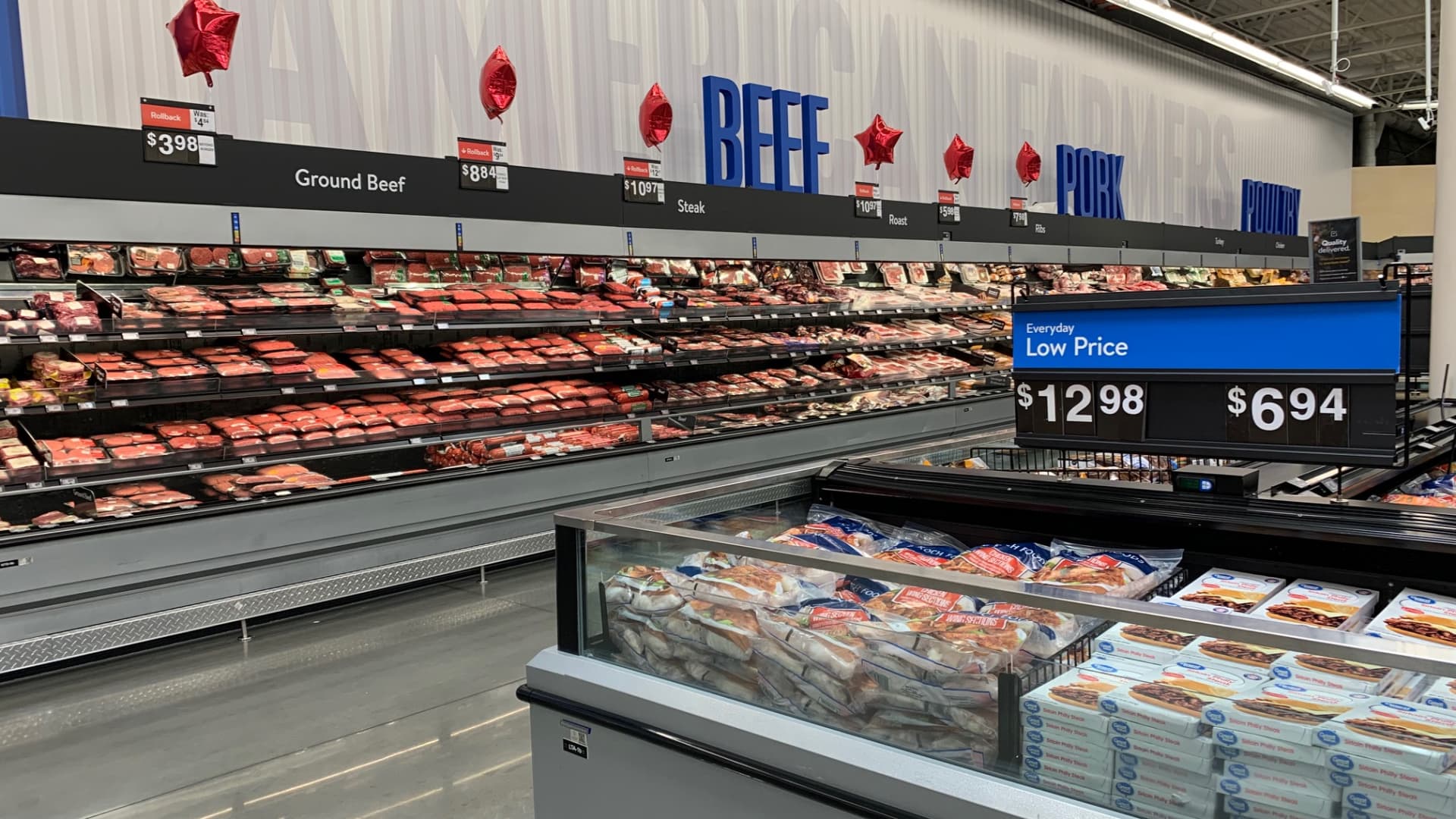
As more grocery shoppers opt for higher quality meats, Walmart said Wednesday that it is investing in a company led by ranchers and beef producers to bulk up its supply.
The retailer is taking a minority stake in Sustainable Beef, which plans to open a processing facility in North Platte, a small town in west-central Nebraska that is home to the former ranch of storied Western showman Buffalo Bill Cody. It expects to break ground next month and create 800 jobs.
Walmart declined to disclose the specific amount of its investment. As part of the deal, however, the retailer will get the majority of beef produced at the facility, which is expected to open by late 2024, said Tyler Lehr, senior vice president of merchandising for deli services, meat and seafood for Walmart U.S. It will also get representation on the company's board.
For the retailer, the deal means a larger, more consistent supply of beef, including better cuts. For shoppers, it will show up in the form of ground beef and steaks — including ribeye, sirloin and New York strip — in its meat department. Walmart will source Angus from the company, a type of beef that comes from a cattle breed often associated with more flavor because of its marbling.
The beef will hit store shelves in the central part of the country starting in late 2024, Lehr said.
A beefed-up grocery strategy
Walmart, the country's largest grocer by revenue, is making investments in agriculture and food production as consumers eat differently and crave more information about the items they toss in their shopping carts. The company invested earlier this year in Plenty, a California-based startup that grows leafy greens indoors and closer to urban centers. The agriculture method of vertical farming uses less water, eliminates the need for pesticides and requires less transportation to get to the store shelf.
Two years ago, Walmart opened a beef-processing facility for Angus beef in Thomasville, Ga., and in 2018, it opened a high-tech dairy plant in Fort Wayne, Ind.
The Sustainable Beef investment also feeds Walmart's environmental and social commitments. By 2030, the retailer, along with the company's foundation, has pledged to protect, restore or more sustainably manage at least 50 million acres of land and 1 million square miles of ocean by 2030. And two years ago, it said it would work toward sourcing more sustainable fresh beef by working with ranchers on grazing management, grain sourcing and more.
Groceries drive almost 60% of Walmart's U.S. sales, according to its most recent annual report. Fresh groceries like fruits, vegetables and meats are especially a growth driver and influence where people choose to shop, Lehr said.
"Customers continue to tell us one of the biggest points of differentiation is they want to know where it comes from," Lehr said. "They like to know and learn a little bit more about it rather than just seeing it on the meat counter. There's a greater drive and desire for them to know what the backstory is on the products that they're purchasing in store."
Sizzle and steak
During the past months of rising inflation, Walmart's reputation for low prices has attracted middle- and high-income shoppers looking to save on groceries and essentials, including some who may seek premium cuts of meat. In the most recent quarter ended July 31, Walmart said about three-quarters of the company's market share gains in food came from customers with annual household incomes of $100,000 or more.
The discounter cut its full-year profit guidance last month, but increased its projections for sales growth, citing gains in its grocery category.
Grocery shoppers, especially younger generations, expect more from their food — even as they watch their budget, said Rob Dongoski, food and agribusiness leader for consulting firm EY. Along with seeking tasty and affordable items, they consider other attributes, such as whether an animal was treated humanely or if produce was grown in a more sustainable way. They may look for labels associated with health or wellness, too, such as "organic," "grass-fed" or "antibiotic free."
If you look at Gen Zers and millennials, cars and houses are more needs-based and food is more status.Rob Dongoskifood and agribusiness leader, EY
And, Dongoski said, some of those consumers are willing to pay more for them.
"There's a renewed interest in food," he said. "Boomers and Gen Xers affiliated status with their car and their house and food was a necessity and needs-based purchase. If you look at Gen Zers and millennials, cars and houses are more needs-based and food is more status. We've seen a real difference in that attitude."
Those evolving preferences have changed the look of Walmart's meat department, too. On a store tour earlier this summer with Walmart's Chief Merchandising Officer Charles Redfield near the big-box retailer's Arkansas headquarters, he pointed to fridges full of beef.
Inside of the chilled area, there is now a larger number of steaks on black trays versus white ones. The black trays are for choice beef, a higher-quality cut that's juicier and more flavorful, and the white trays are for select beef, a lower standard of meat that's less marbled and tender.
Three or four years ago about 70% of steaks at stores were in the white trays, he said; now, the mix has flipped.
"company" - Google News
August 31, 2022 at 08:00PM
https://ift.tt/0HMRrv9
Walmart invests in ranchers' company as more shoppers opt for premium beef - CNBC
"company" - Google News
https://ift.tt/vGJh5uD
https://ift.tt/b6uxLvP
Bagikan Berita Ini















0 Response to "Walmart invests in ranchers' company as more shoppers opt for premium beef - CNBC"
Post a Comment